Gaillardia pulchella, Firewheel
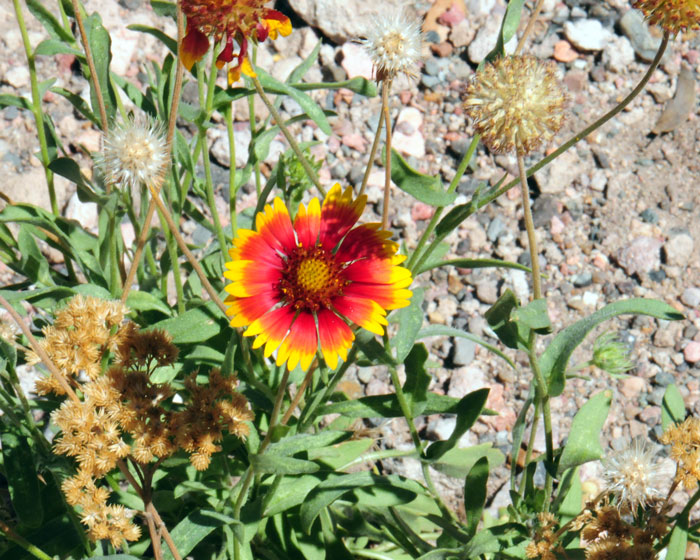
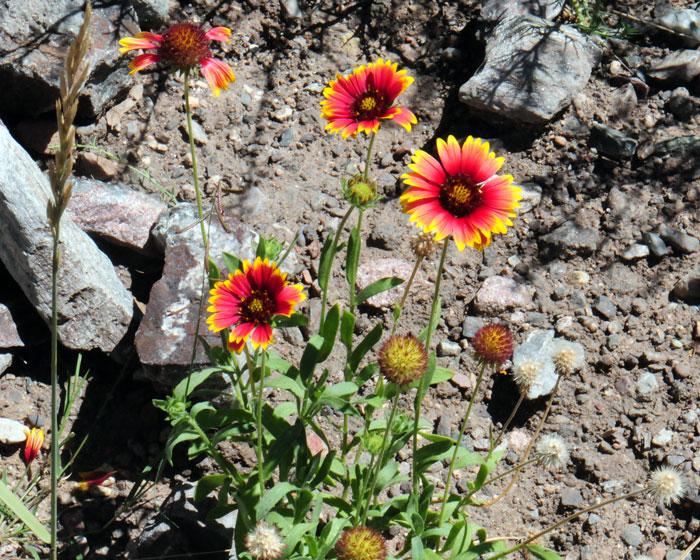
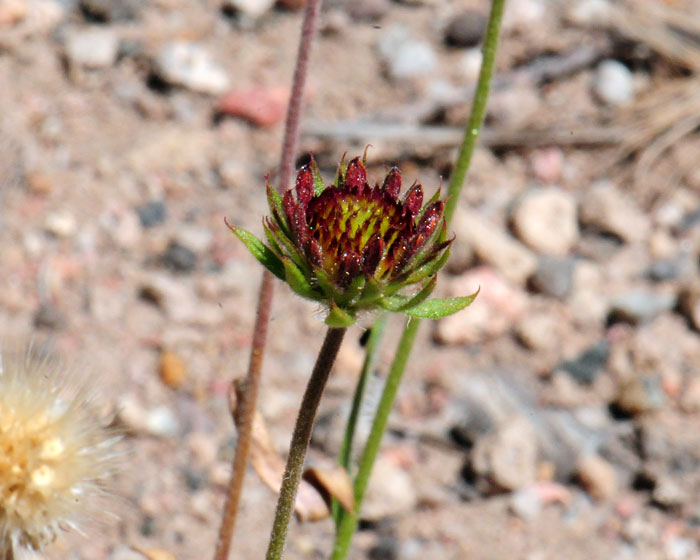
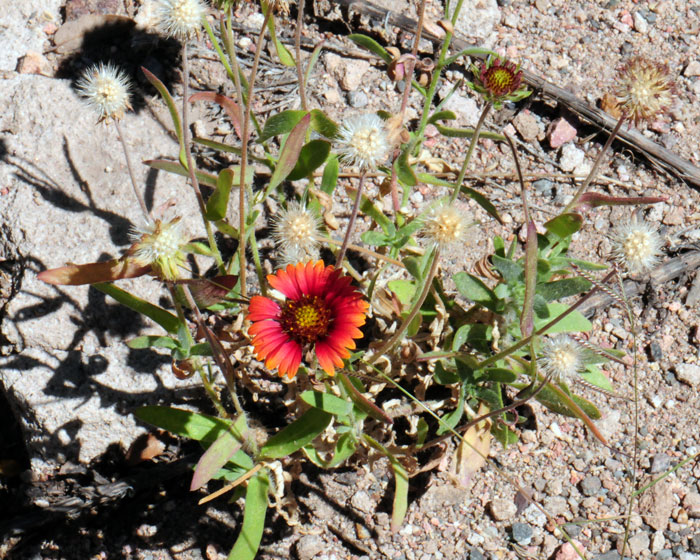
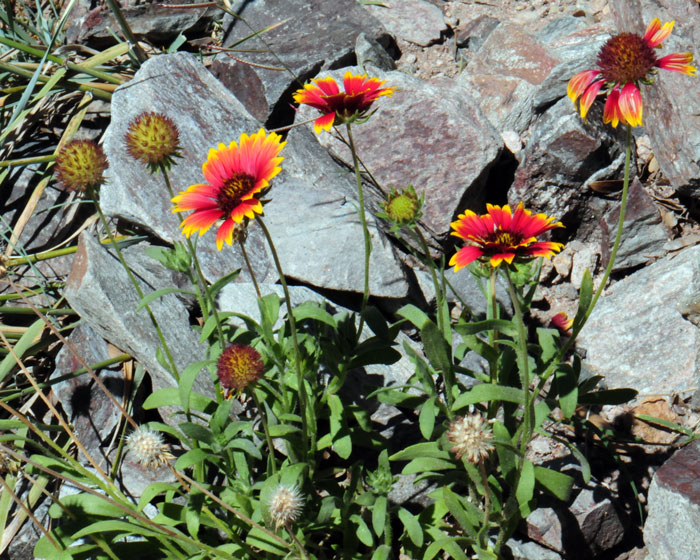
Scientific Name: Gaillardia pulchella
Common Name: Firewheel
Also Called: Indian Blanketflower, Indianblanket, Rosering Gaillardia, Sundance
Family: Asteraceae, Sunflower Family
Synonyms: (Gaillardia bicolor var. drummondii, Gaillardia drummondii, Gaillardia neomexicana, Gaillardia picta, Gaillardia villosa)
Status: Native
Duration: Annual, biennial or perennial.
Size: 1 to 2 feet (30-60 cm) tall
Growth Form: Forb/herb or subshrub; main stem and many branches hairy, center base stem may become woody; plants generally erect; plants rough hairy throughout.
Leaves: Green; leafy near base, blades linear to oblong and some spatulate; lower leaves (basal) with supporting stalk and upper leaves (cauline) without a stalk (sessile); generally the leaf edges (margins) generally without teeth or with teeth or even lobes; leaves mostly rough (strigose) in texture.
Flower Color: Red with yellow tips, or red or purplish along the tips, flowers showy 1 to 2 inches (2.54-8 cm) wide; flower heads with both ray (0 or 8 to 14) and disk (40 to 100) florets; ray flower tips reddish-brown with 3-lobes; fruit is a cypsela.
Flowering Season: April or May to August or January through December with amply summer monsoon rainfall.
Elevation: 3,500 to 5,500 feet (1,066-1,676 m)
Habitat Preferences: In Arizona along roadsides, sandy or calcareous soils, often in disturbed areas, dry plains, grassy areas; prefer well drained soil.
Recorded Range: Firewheel is Native to most of the eastern half, southern half and southwest areas of the United States, absent in the northwest states; also occurs in northeast Canada and northeast Mexico, Chihuahua, Coahuila, Nuevo León, Sonora, Tamaulipas. It is found throughout the southwestern United States, except Utah where there are no records.
In Texas it prefers dry plains & open areas, widespread in calcareous and sandy-calcareous prairies in the western two-thirds of the state; well-drained sand, loam, calcareous soils.
North America & US County Distribution Map for Gaillardia pulchella.
North America species range map for Firewheel, Gaillardia pulchella:
North American range map courtesy of Virginia Tech, Dept. of Forest Resources & Environmental Conservation
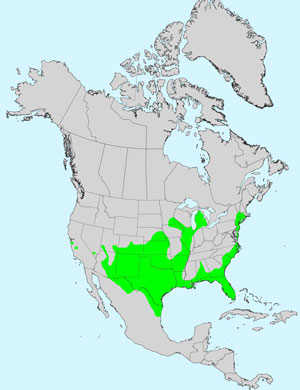
U.S. Weed Information: Unknown
Invasive/Noxious Weed Information: Unknown
Wetland Indicator: In North America Gaillardia pulchella has the following wetland designations:
UPL = Obligate Upland, almost never occur in wetlands
FACU = Facultative Upland, usually occur in non-wetlands, but may occur in wetlands
Threatened/Endangered Information: Unknown
Genus Information: In North America there are 12 species and 22 accepted taxa overall for Gaillardia. Worldwide, The Plant List includes 24 accepted species names and a further 43 scientific names of infraspecific rank for the genus.
The genus Gaillardia was published in 1788 by French plant physiologist, archaeologist, and naturalist Auguste Denis Fougeroux de Bondaroy.
In the Southwestern United States: Arizona has 6 species of genus, California has 2 species, Nevada has 3 species, New Mexico has 4 species, Texas has 7 species, Utah has 6 species. Data approximate and subject to revision.
There are 3 varieties in Gaillardia pulchella;
Gaillardia pulchella var. australis, (TX)
Gaillardia pulchella var. picta, (AL, FL, GA, LA, MS, NC, SC);
Gaillardia pulchella var. pulchella, (generally SW U.S. & eastern half of U.S.).
Comments: Firewheel or Indian Blanket is a beautiful showy plant one might expect to find in well maintained gardens. Indian blanket is a major wildflower of the prairies and meadows. In fact Firewheel thrives under cultivation and several varieties of been developed in an array of colors.
Firewheel is the state wildflower of Oklahoma.
Firewheel is extremely adaptable and often found in disturbed areas, along roadsides and dry areas with sandy soil. Flowers from late spring through fall and blooms may be extended by late summer monsoons. Because of their beauty and hardiness, this wildflower, and many others are seeded along roadsides by highway departments. So much so that I am always suspicious of the “naturalness” of wildflowers blooming along roadways.
For information on the home propagation of Firewheel see the Lady Bird Johnson, Plants Database page this species at this link.Also see in Southwest Desert Flora, Red Dome Blanketflower, Gaillardia pinnatifida.
Special Value to Native bees; Gaillardia pulchella is recognized by pollination ecologists as attracting large numbers of native bees. See Plants for Pollinators: Blanketflower; and also see the Pollinator Conservation Program. This information was provided by the Pollinator Program at The Xerces Society for Invertebrate Conservation.
The genus Gaillardia was published in 1788 by French plant physiologist, archaeologist, and naturalist Auguste Denis Fougeroux de Bondaroy.
The species epithet “pulchella” (pulchel'la/pulchel'lum/pulchel'lus:) derived from the Latin for “beautiful.”
See complete listing of ethno-botanical uses at Native American Ethnobotany, University of Michigan, Dearborn.

